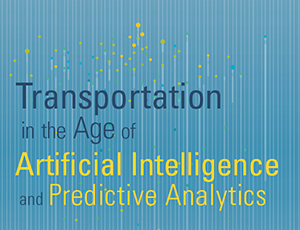The Four Roles of Government in a New Mobility Operating System
A new mobility operating system requires government, especially at the city-level, to design transportation around the user—not the mode—according to Stephen Goldsmith, Director of the Innovations in American Government Program at Harvard’s Kennedy School of Government.
Governments pursuing new mobility operating systems will have data-driven protocols, not strict regulations. They will seek rules that make markets work for citizens. And they will give regional planners real authority.
Watch video highlights from Goldsmith's talk as part of Volpe's 2018 speaker series, Transportation in the Age of Artificial Intelligence and Predictive Analytics.
Transportation Meets User Experience
In Indianapolis, where Goldsmith was mayor from 1992 to 2000, the number of taxi medallions was limited by law. But people in neighborhoods who needed taxi services most were not getting them, and those who wanted medallions lived in those neighborhoods—but couldn’t get them, Goldsmith said.
The issue, in addition to medallion caps, was a transportation system designed around a mode—taxis—instead of a system that promoted cross-modal mobility.
“If we think about the user experience of mobility, if we design a system around the user, that’s different than designing a system around the user of a bus, or a taxi, or a transportation network company, or a bike,” Goldsmith said during the U.S. DOT Volpe Center’s Transportation in the Age of Artificial Intelligence and Predictive Analytics speaker series. “If we’re thinking about a system designed around the omni-channel experience of the user, and if we could come up with that orientation, it would dramatically change things.”
Coding the Curb
Curb space used to be a maintenance liability for governments. Today, the curb is valuable, Goldsmith said. But most cities don’t know where their signage is, and the curb is not coded to evaluate the cost of using part of the curb to drop off from a transportation network company vehicle, or perhaps an automated vehicle.
Los Angeles is one city innovating with curb space through its Code the Curb program. Code the Curb is identifying where curb assets are located and seeks to use dynamic pricing related to curb use, Goldsmith said.
“As we think about managing mobility, we also need to think inherently about managing the curb,” Goldsmith said. “Not managing parking, but managing the curb.”
Making Transportation Markets Work for Residents
The government role over the past 25 years has been to provide transportation, like bus transit, or to regulate transportation, like with taxis. In a new mobility operating system, the government’s core responsibility is not operation, but equity: to ensure communities are served broadly, fairly, and openly, Goldsmith said.
Data that is real-time, accurate, and comes from multiple sources can help encourage transportation equity. The government can act as a data aggregator that can inform pricing and consumer decisions, Goldsmith said.
“One of the things we need to consider in this new government role is, what information should government require from a commercial operator in its jurisdiction as a condition to use its easements and streets?” Goldsmith said. “What’s in real-time? What’s not in real-time? What formats? How is privacy handled? How is anonymity handled? And we need to get there. Sometimes it will be relatively easy to negotiate data-sharing agreements, and other situations are more complex.”
Regional Planning With Authority
With enormous amounts of information and the ability to code the curb, government can take a more enlightened approach to managing mobility, Goldsmith said. Government structures, however, may not be up to the challenge. In most places, transit organizations like metropolitan planning organizations (MPOs) are the only regional transportation government bodies, but MPOs may not have the authority to innovate at the city level.
“I would suggest we need to think about new governance structures,” Goldsmith said. “We need to think about regional governance and more authority for the MPOs, we need to think about what the platform looks like. Volpe is a terrific place to suggest what the protocols and analytics should look like in those platforms.”
Watch full remarks from Goldsmith's talk as part of Volpe's 2018 speaker series, Transportation in the Age of Artificial Intelligence and Predictive Analytics.

